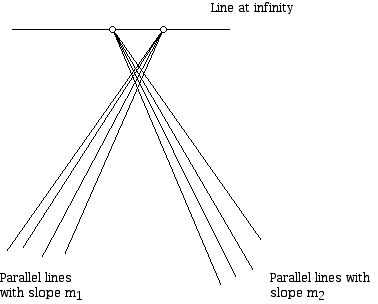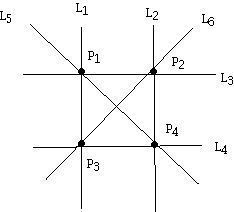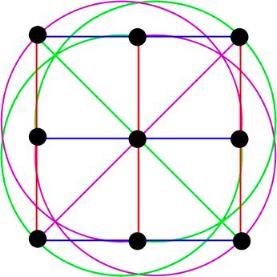
Geometric Structures: Session X
From Finite to Infinite Geometries
Prepared by:
Joseph Malkevitch
Department of Mathematics
York College (CUNY)
Jamaica, New York 11451
email:
malkevitch@york.cuny.edu
web page:
http://york.cuny.edu/~malk
From Affine to Projective Planes and Back
The diagram below suggests the classical way, pioneered during the Renaissance of how to take an affine plane, and "complete" it to a projective plane. Old lines (the original affine lines) of the affine plane have a single point added to each, to get the new lines of the projective plane. The same new point is put on all of the lines which are parallel to each other in the affine plane. Thus, all the lines in a parallel class now meet in a point which is thought of as being at infinity. Lines in different parallel classes have different points added. The old points of the affine plane are augmented with one new point for each parallel class of the affine plane (as just indicated), and all of these new points are placed on a single line in the new projective plane, usually called the line at infinity. The intuition here is that parallel lines appear to meet at points which are at "infinity."

Using the axioms for a finite affine plane together with the laws of logic one can derive theorems about the finite planes. For example, we can prove that all of the lines of a finite affine plane of order n have the same number of points on them, namely, n points. How might one get started to prove this? Since there is one line with n points let l be that line. We also know that not all of the points can be on a line (since there exist 4 points no three collinear) so there must be a point P which is not on l. How many lines go through P? We can join P to all of the n points on l, giving n lines, but there is also one parallel to l through P, so there are exactly n + 1 lines through P. Suppose m is some line different from l and not containing P. Can you see how to prove that there is such a line? (It will turn out but one has to prove this, that in a finite affine plane of order n, there are always exactly n2 + n lines.) Once we know there is such an m, all of the lines through P, and we know there are n + 1 of them, must intersect m except for the one line through P parallel to m. Thus, there are exactly n points on m. With care, one can show that all of the lines in the plane have n points, and all of the points in the plane have exactly n + 1 lines through them. In the end, the "statistics" for a plane of order n are: n points on any line; n + 1 lines through any point; exactly n2 + n lines; exactly n2 points; exactly n lines parallel to a given line (and recall that any line is considered parallel to itself). The lines all parallel to a given line are known as a parallel class. The number of parallel classes in a finite affine plane is n +1. The parallel classes partition the lines of the plane (pairs of parallel classes have no lines in common and the collection of all parallel classes include all of the lines). Each parallel class includes all of the points in the plane. You can verify these facts for the two affine planes below:
affine plane of order 2:

affine plane of order 3:

Are there many different affine (projective) planes of a given order? It will probably not surprise you that for small values of n all affine planes of order n are isomorphic but as n gets larger there are many inequivalent finite affine planes. Since we can construct a projective plane from an affine plane there are also many non-isomorphic projective planes of given large order n. In particular, there are 4 non-isomorphic affine and projective planes of order 9.
We will now explore the pedagogical (educational) aspects of the fact that one can go back and forth between examples of finite and infinite affine (Euclidean), projective, and Bolyai Lobachevsky Planes.
While the origins of geometry were first done in coordinate free settings, eventually all of the tree major geometries were made more "algebraic." Euclid developed the synthetic approach to Euclidean geometry but Fermat and Descartes developed analytical geometry in the 17th century. One way to think of analytical geometry is that it is an algebraic way of looking at the geometry of the Euclidean plane. While the ideas of projective geometry were initially developed by Renaissance artists such as Leon Battista Alberti, Leonardo da Vinci, Albrecht Dürer, Piero della Francesca and others, analytical approaches to these ideas came much later. This was through the development of the idea by August Fredinand Möbius (and Jacob Steiner) of homogeneous coordinates and other tools and concepts.
Usually, when we do analytical geometry we use pairs of real numbers to represent points. So (x, y) represents a point) and linear equations (ax + by +c = 0, a, b, not both zero) represents a line. Note, however, that the equations of lines are "asymmetric" in the sense that c is not the coefficient of a "variable." Furthermore, while (2, 4) is a different point from (4, 8) the lines 2x + 4y = 0 and 4x + 8y = 0 are the same. This asymmetry can be "fixed" but with a relatively small price, and in some ways a great gain. What was noticed in the 19th century is that points could be represented as triples of real numbers, (x, y, z) where x, y, z are not all zero. Thus, (x, y, z) and (kx, ky, kz) where k is not zero are the SAME point. Lines now are those equations ax + by +cz = 0 where a, b, and c are not all zero. Not that unlike the usual equations of lines we never have a constant term appear by itself, as in the Euclidean case: 3x + 2y + 9 = 0. Representing points in this way involves what have come to be called homogenous coordinates.
Example: (4, 2, 2) is the same point as (2, 1, 1) and lies on the line -x + y + z = 0 which is the same line as 2x - 2y - 2z = 0.
Now suppose we have two line x + y - z = 0 and x - y + z = 0. Since we have two equation in two unknowns we can use linear algebra (or high school algebra) to see what is the solution set of these two equations. The answer is any point with first coordinate x = 0 and y = z.. (When you add the equation above you get x = 0. Substituting in the remaining equations means y = z). You can check (0, 1, 1) and (0, -3, -3) satisfy the above pair of equations. However, both of these are the same point point! If you work out the general case you will see that distinct lines always intersect in a unique point. Thus, these coordinates are not the points of the Euclidean analytical geometry but of a new geometry which is now called the real projective plane.
Using a synthetic approach we will see how to take an affine geometry and use it to construct a projective plane. When one starts with Euclidean geometry the construction results in the real projective plane. When the constructions starts with the affine geometry with 4 points and 6 lines (the affine plane of order 2) the result is the projective plane of order 2, the Fano Plane. We will give a way using finite arithmetics (the integers mod p and more generally the Galois Fields, which are know to exist if only one has a prime power number of elements), to construct a finite affine plane. If the field has a prime power number of elements n, then the affine plane has order n, that is, n points on a line. The associated projective plane has order n with n + 1 points on each line.
You can verify that the real projective plane obeys the axioms for a projective plane.